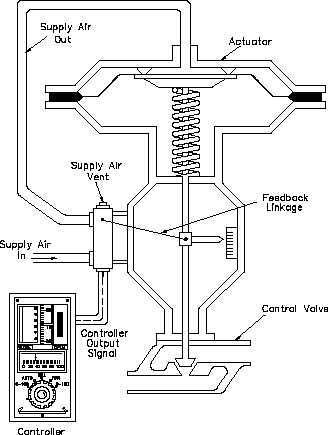VALVE ACTUATORS
Process Controls
For example, as the control signal increases, a valve inside the positioner admits more supply air
Figure 36 Pneumatic Actuator with Controller and Positioner
to the actuator. As a result, the control valve moves downward. The linkage transmits the valve
position information back to the positioner. This forms a small internal feedback loop for the
actuator. When the valve reaches the position that correlates to the control signal, the linkage
stops supply air flow to the actuator. This causes the actuator to stop. On the other hand, if the
control signal decreases, another valve inside the positioner opens and allows the supply air
pressure to decrease by venting the supply air. This causes the valve to move upward and open.
When the valve has opened to the proper position, the positioner stops venting air from the
actuator and stops movement of the control valve.
An important safety feature is provided by the spring in an actuator. It can be designed to
position a control valve in a safe position if a loss of supply air occurs. On a loss of supply air,
the actuator in Figure 36 will fail open. This type of arrangement is referred to as "air-to-close,
spring-to-open" or simply "fail-open." Some valves fail in the closed position. This type of
actuator is referred to as "air-to-open, spring-to-close" or "fail-closed." This "fail-safe" concept
is an important consideration in nuclear facility design.
IC-07
Page 56
Rev. 0

